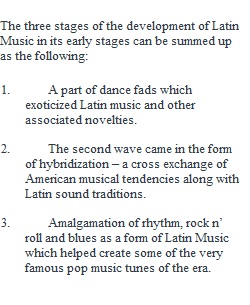


Q Unit 8 Latin Music in the United States 1900's-1950's Latin music entered the US in three stages. Briefly explain what those three stages were. What are the Latin dances that are imported to the US? Give a brief explanation/definition of each. On a personal note, have you ever learned any of these dances? I have learned a few in ball room dancing. What are unique instruments that are associated with Latin American music? Share if you have ever played these instruments. How is Latin music mainstreamed into American popular music? There are only a few musicians and songs in this unit. Choose a musician or song to share about. Personal experience: Have any of you grown up in the Latin culture, or traveled to a Latin country? If so, feel free to share your experience. Unit 9 Popular Music Matures, Musical Theater, Modern Jazz, Song Interpretation In the opening page, how did media and technology help American pop music mature? Rodgers and Hammerstein have always been synonymous with musical theater ( musicals). Are there any musicals listed that you have seen or been a part of acting/singing/or playing in the pit orchestra? ( I have played in quite a few pit orchestras) Share your experience. There are other musicals not listed. How did "South Pacific" help break the race barrier? What did Leonard Bernstein do to bring modern music and racial divisions to light in "West Side Story" ? Why is this musical different through out and especially at the end in comparison to musicals that preceded it? Explain modern jazz and the direction it goes after 1945, both instrumentally and vocally? The vocal end is associated with song interpretation. Name a musician or artist from this unit that made an impact on you and why.
View Related Questions